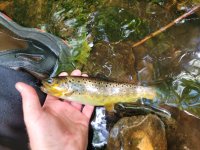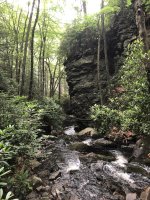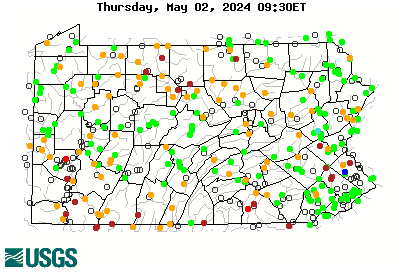No kidding, in every stream mentioned here, browns are rare. There's an awful lot of brookie streams you could fish 30 times and never catch a brown, then on the 31st time... Or a buddy catches one. There is a token brown trout population virtually everywhere.
That is not to say allopatric doesn't exist. There are circumstances where it happens. Namely, barriers, whether they be natural, man-made, chemical, or whatever. Brown trout exist in every major waterway in PA, and they travel, so without a barrier, the tribs of those waterways, and the tribs of the tribs, get the occasional brown trout. And aside from travellers, they seem to be able to have low level reproducing populations underneath vibrant brook trout populations. In cases where the physical habitat changes to favor browns, a brown trout population is already present in most cases. The exceptions are just that, exceptions, and the most typical reason is that the stream is completely isolated by a barrier.
The point of all of this. In the case of Elders. I don't think it matters whether Middle Creek, at the mouth of Elders, has large wild browns stacked like cordwood, or just the occasional passer by. Elders almost certainly already has browns in it. And there are 1000 other primarily brook trout streams in PA that have the same situation. If Elders, for instance, experienced say, siltation, which degrades the viability of brook trout more than brown trout, then the population of browns will increase. It does not lack population seeders, and the argument that you shouldn't help the browns downstream because it would create population seeders doesn't hold merit, because they are already there. Binary, they are or they aren't. And if they aren't, then they aren't because there's a barrier preventing it, in which case the population of browns below the barrier doesn't matter either.
I am a brook trout fan. I love them. I want to protect them. And if you say, hey, Elders needs to be protected from browns. Lets erect a barrier to prevent entry. Lets shock Elders to get any small population that exists out of there. I could be convinced. But I do not believe that an effort to help the browns in Middle, for instance, will have any effect whatsoever on Elders. Because brookies aren't currently holding on in Elders due to a lack of browns in Middle. Middle already has browns, in enough numbers to seed Elders if Elders were open to being seeded.
As for the barrier idea. It gets tricky. Is it better to have a barrier, and shock out the browns above, to prevent entry by brown trout? Or not to have a barrier in order to protect brook trout access to middle creek at certain times of the year? Brook trout are already winning in elders, maybe they'd be better served by having access to Middle? I don't know the answer to that. But I'm interested in it. And yeah, I'd side with whatever I think is best for the brookies in Elders. But if someone was trying to improve the situation for browns in Middle, I'm on their side too.







